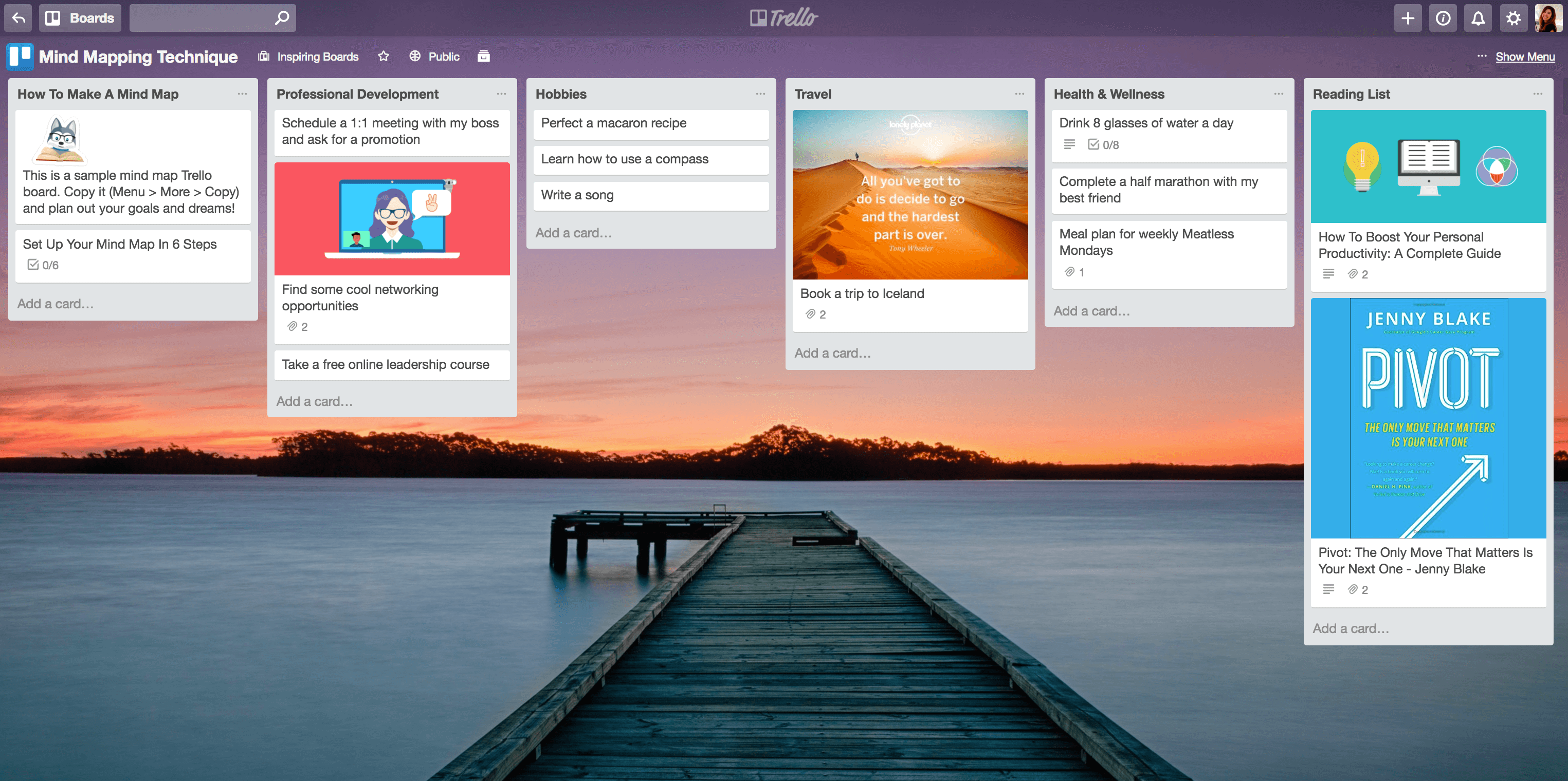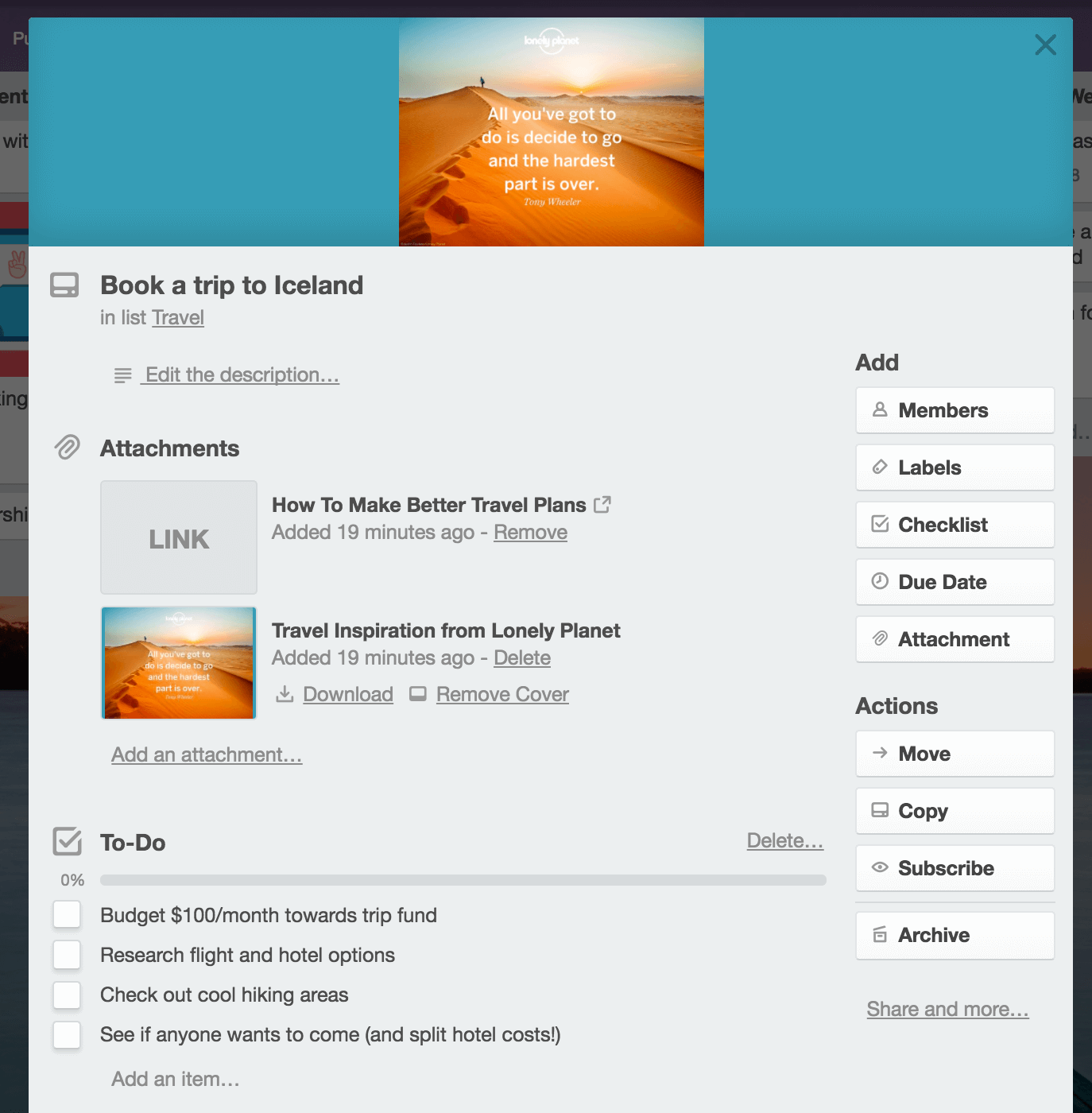Ever feel like your goals are rich with potential, but a little scarce on productive outcomes?
Sometimes you just need to get things out of your head and into the world to truly visualize them. This is the exact strategy behind mind mapping, a goal-setting technique that visually lays out your plans, interests, and aspirations.
A mind map is a diagram that visually organizes information by branching ideas out from a central theme to highlight connections between the whole concept and its parts. It’s a creative, wheel-and-spoke way to brainstorm goals across the different areas in your life with the whole perspective in view—and it works.
Turning Away From Linear Thinking
Jenny Blake, former Google career development manager and author of PIVOT: The Only Move That Matters is Your Next One, is a champion of the mind mapping method. She believes it’s the best way to get to the root of what is most important to you, and frees your thinking process from the typical constraints of linear thinking.
Life rarely follows a linear path, so it stands to reason that goal setting won’t either. When it comes to milestones such as professional growth, factors like evolving technology, automation, and distributed work have moved the needle on what a typical “career” looks like. This reality is what has driven Jenny to author a book and launch the Pivot strategy, which helps professionals stay agile and achieve their goals.
Using the mind map method to gain perspective on all of your life’s aspirations may help you make connections and draw conclusions that stretch beyond the confines of traditional goal setting. We sat down with Jenny to get her best tips for setting up a mind map of your own:
Mind Mapping 101
Trello: Why is it important that we stop to map out our goals? Why do you think people avoid or neglect to do more personal planning?
Jenny: We need a new word for goals. For many people, goals have become associated with shoulds, something akin to New Year’s resolutions that we set and forget, only to beat ourselves up six months down the road. That’s why I love doing mind maps for creating a more expansive vision—mind maps allow you to write down anything and everything that comes to mind across various areas of your life.

“We need a new word for goals. For many people, goals have become associated with shoulds, something akin to New Year’s resolutions that we set and forget, only to beat ourselves up six months down the road.”
What would be most exciting for you to pursue in areas such as work, health, learning, relationships, fun, or creative projects? If goals and milestones are helpful for you, by all means write them down—but for me, the real goal has become working on something so resonant that I’m excited to spend time on it every day, no matter what.
Mind maps give me the space to brainstorm freely, then check-in every few months to see what I can take small next steps toward.
Trello: What are the main steps to follow when building a mind map?
Jenny: Write a theme in the center of the page, such as “2018” or “values” or a creative project or anything else that you’d like to brainstorm visually and non-linearly about. From there, draw spokes to categories of items.
If it’s setting intentions for the year ahead, write down areas of life that are important to you. If it’s a creative project or a book, write down thematic topics that you want to brainstorm in greater detail.
From those main spokes, do a free-write of anything that comes to mind for tertiary spokes – it could be specific ideas or goals for each of the themes you chose, or it could be reasons or keywords about why those ideas resonate with you and the impact you’d like them to have – or both.
Bottom line: there are no rules! Let your pen wander across the page, and try not to censor yourself. When you think you’re done, keep going—that just means you’ve captured your most obvious ideas.
Trello: In your book, PIVOT, you talk about how small steps towards change are key for making a big move. How should a person apply this strategy to their goal setting?
Jenny: For every goal or mind map area, ask these two questions: what one next step would have the biggest impact? And what one small step could I take in the next week? If you focus on just those two things, week after week, you’ll be generating massive momentum in no time!
Trello: When goals are set, are they set in stone?
Jenny: Not at all; goals are meant to be fluid. Hold a vision for the outcome but make sure you’re enjoying the process. If you’re not, it’s a signal—an invitation to change your approach and learn something new about yourself in the process.
Trello: After a mind map is complete, what’s next? How can we use it to stay on track and achieve our goals?
Jenny: Put it where you can see it, or at least revisit it every few months. Don’t worry about tracking it super closely (unless that strategy works for you); many of the ideas you’ve captured will stay in your subconscious and start working without you even realizing it.
You might also set a monthly mind-map check-in appointment with yourself (with a reminder in Google calendar) so that you can review and determine what small next steps might energize you most.
Building A Mind Map In Trello

Mind maps are typically drawn out on paper, but setting up a mind map in Trello is an easy way to explore the concept. It could also be a handy digital reference of your paper mind map that is accessible anytime from your computer or mobile device. Just follow these simple steps and you’ll be brainstorming in no time:
- Choose a board name that references the theme, project, or time frame for the mind map.
- Set each list to represent a different area of your life that is important to you.
- Create a card for each idea, goal, or keyword that inspires you, and put it in its corresponding life area list.
- Get creative with inspiring card covers and board backgrounds to give it that “visual” feel.
- If you have links to videos, articles, or images that expand your inspiration, add those to the cards, or write in notes or ideas that spring up.
- Use checklists to break down goals into actionable steps, add due dates if you want to set deadlines, and invite collaborators onto the board if you want to bring on some accountability partners!
- If you want a more free form experience, consider enabling a Power-Up like SmartDraw to create a diagram or draw a mind map right from your board.

Full disclosure: Jenny and her team use Trello for managing day-to-day tasks and ideas, but hadn’t given it a try for mind mapping. However, she did think it would be an interesting method of building out perspective on goals:
“Trello is a super functional, fluid way to translate a hand-drawn mind-map into something actionable. I love the idea of having boards for different areas of the mind-map, and tracking and dynamically moving around various cards for each one, checking them off as they are completed (and perhaps even having a “done” board so you can celebrate how far you’ve come along the way).” – Jenny
Why not switch up your perspective on goal setting right now? Copy this Mind Map sample board, customize it with the tips above, and start exploring all of life’s possibilities!
Next: The Psychology Of Checklists: Why Setting Small Goals Motivates Us To Accomplish Bigger Things





 )
) 




































